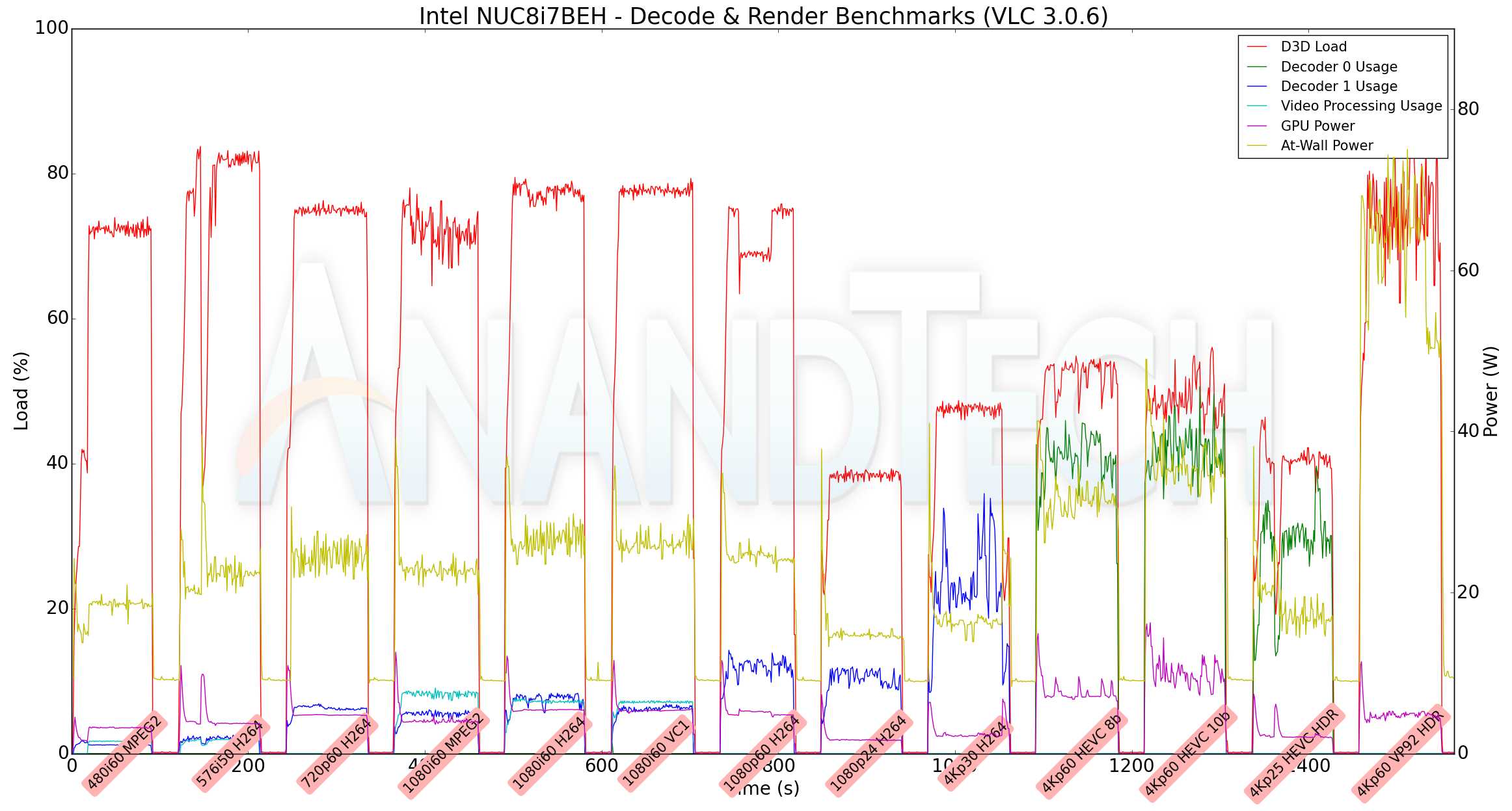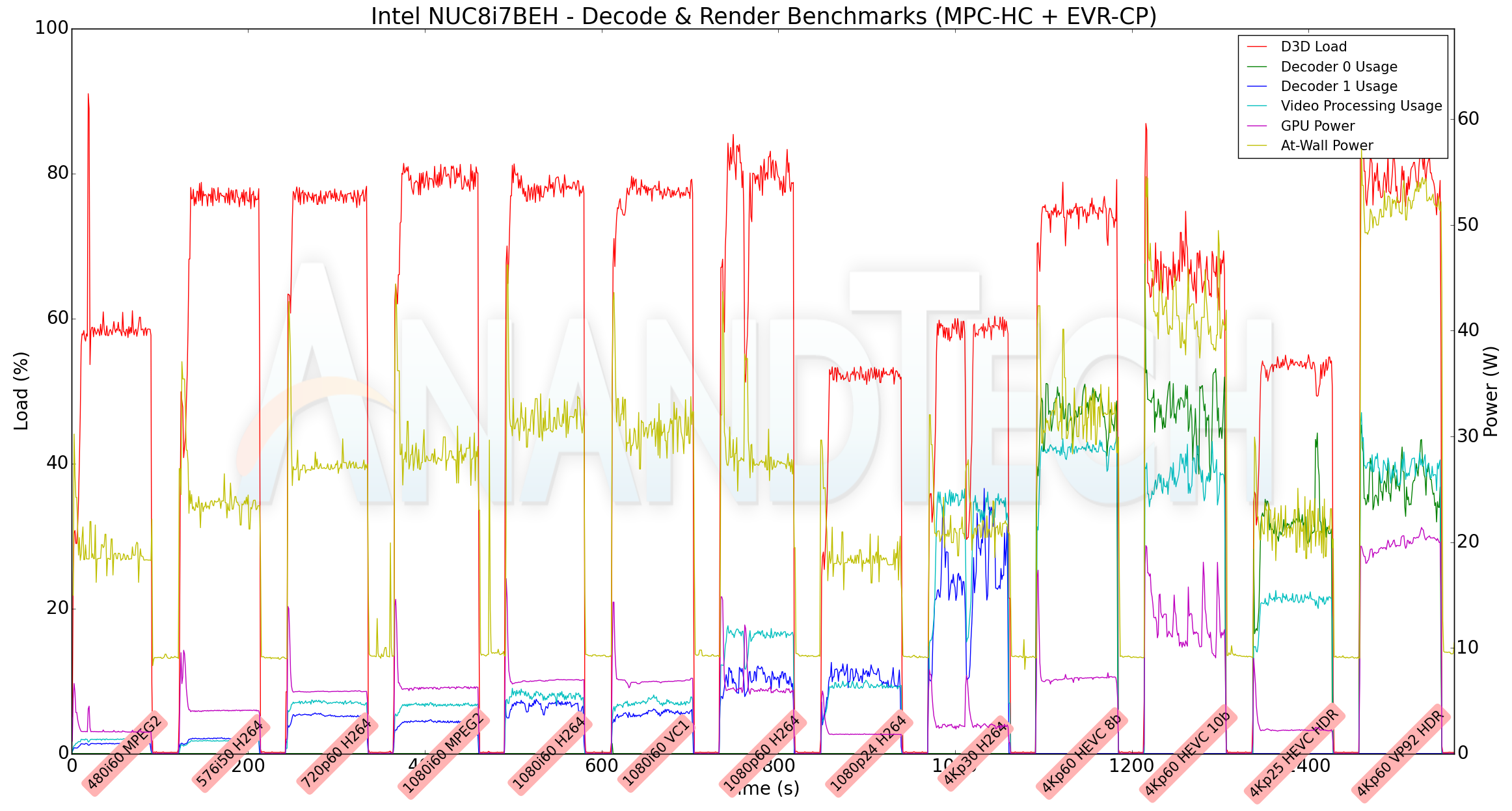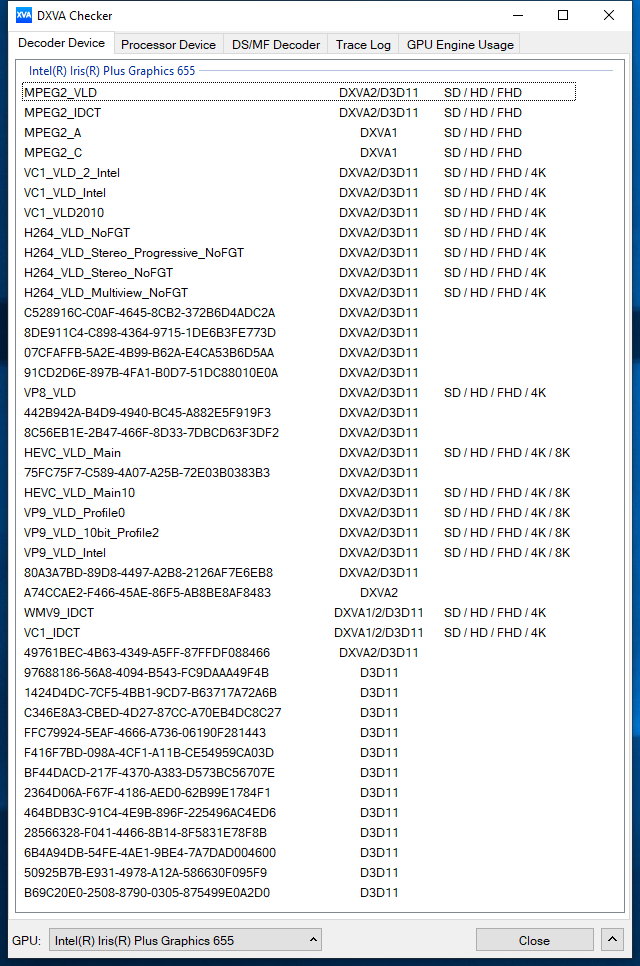Intel's Bean Canyon (NUC8i7BEH) Coffee Lake NUC Review - Ticking the Right Boxes
by Ganesh T S on April 3, 2019 8:00 AM EST- Posted in
- Systems
- Intel
- NUC
- UCFF
- Thunderbolt 3
- Cannon Point
- Coffee Lake-U
HTPC Credentials - Local Media Playback and Video Processing
Evaluation of local media playback and video processing is done by playing back files encompassing a range of relevant codecs, containers, resolutions, and frame rates. A note of the efficiency is also made by tracking GPU usage and power consumption of the system at the wall. Users have their own preference for the playback software / decoder / renderer, and our aim is to have numbers representative of commonly encountered scenarios. Towards this, we played back the test streams using the following combinations:
- MPC-HC x64 1.8.5 + LAV Video Decoder (DXVA2 Native) + Enhanced Video Renderer - Custom Presenter (EVR-CP)
- MPC-HC x64 1.8.5 + LAV Video Decoder (D3D11) + madVR 0.92.17 (DXVA-Focused)
- MPC-HC x64 1.8.5 + LAV Video Decoder (D3D11) + madVR 0.92.17 (Lanczos-Focused)
- VLC 3.0.6
- Kodi 18.1
The thirteen test streams (each of 90s duration) were played back from the local disk with an interval of 30 seconds in-between. Various metrics including GPU usage and at-wall power consumption were recorded during the course of this playback. Prior to looking at the metrics, a quick summary of the decoding capabilities of the Intel Iris Plus Graphics 655 is useful to have for context.
The GPU supports hardware accelerated decoding of all popular codecs, including VP9 Profile 2.
All our playback tests were done with the desktop HDR setting turned on. It is possible for certain system configurations to have madVR automatically turn on/off the HDR capabilities prior to the playback of a HDR video, but, we didn't take advantage of that in our testing.
VLC and Kodi
VLC is the playback software of choice for the average PC user who doesn't need a ten-foot UI. Its install-and-play simplicity has made it extremely popular. Over the years, the software has gained the ability to take advantage of various hardware acceleration options. Kodi, on the other hand, has a ten-foot UI making it the perfect open-source software for dedicated HTPCs. Support for add-ons make it very extensible and capable of customization. We played back our test files using the default VLC and Kodi configurations, and recorded the following metrics.
| Video Playback Efficiency - VLC and Kodi | |||

A comparison of the above two graphs for the VP9.2 stream shows that VLC doesn't use hardware accelerated decode for the stream, while Kodi does. With hardware acceleration enabled the system is able to play back all the streams while consuming less than 25W. That said, in general, it appears that Kodi is more power-efficient compared to VLC.
MPC-HC
MPC-HC offers an easy way to test out different combinations of decoders and renderers. The first configuration we evaluated is the default post-install scenario, with only the in-built LAV Video Decoder forced to DXVA2 Native mode. Two additional passes were done with different madVR configurations. In the first one (DXVA-focused), we configured madVR to make use of the DXVA-accelerated video processing capabilities as much as possible. In the second (Lanczos-focused), the image scaling algorithms were set to 'Lanczos 3-tap, with anti-ringing checked'. Chroma upscaling was configured to be 'BiCubic 75 with anti-ringing checked' in both cases. The metrics collected during the playback of the test files using the above three configurations are presented below.
| Video Playback Efficiency - MPC-HC with EVR-CP and madVR | |||

The GPU is able to handle the madVR DXVA configuration, but, the D3D loading jumps above 90% for most streams in the Lanczos configuration. As expected, the NUC8i7BEH is not the system to choose if high-end customized video processing is required. The GPU is simply not up to the task. That said, there is likely no other system with a similar form-factor that can perform better than the Bean Canyon NUC for this particular task.











81 Comments
View All Comments
StevoLincolnite - Wednesday, April 3, 2019 - link
The only thing that hinders me from jumping onto one of these... Is the Intel Decelerator Graphics.AMD needs to apply some much needed competition in the NUC space I think!
notashill - Wednesday, April 3, 2019 - link
Check out the ASRock DeskMini A300 or HP EliteDesk 705, not *quite* as small as the NUC but fairly close and use Ryzen APUs.Irata - Wednesday, April 3, 2019 - link
The AT review of it should be due in a week or two according to Ganesh (he added this as a comment under the Intel based A310).Targon - Wednesday, April 3, 2019 - link
Zotac offers AMD based solutions. I'd wait for the 7nm AMD chips if you can wait, since they will be better for very small machines.sor - Wednesday, April 3, 2019 - link
Zotac is dead to me after teasing the MA551 (the only potential ryzen competitor to the NUC) for over a year and then canceling it. I’m not aware of any Zotac competitors at this level that have a modern AMD APU.I was on the verge of buying one of these NUCs but at the last moment the Asrock A300W came out, which is a much better deal. Far better graphics and cheaper.
Irata - Thursday, April 4, 2019 - link
I think it's good to remember companies who have let us down in the past when making purchase decisions.mikato - Thursday, April 4, 2019 - link
Yes, I kept waiting for that also. I didn't realize they formally cancelled it, I just never heard anything and when I searched periodically I just found other people wondering the same thing.sor - Thursday, April 4, 2019 - link
I came across this thread. I assume “Z_staff” speaks for Zotac.https://www.reddit.com/r/ZOTAC/comments/9af6by/zot...
mikato - Friday, May 3, 2019 - link
Ah. Well good to know finally I guess :/jordanclock - Wednesday, April 3, 2019 - link
They get the Hades Canyon NUC with the Vega M GH? You get a fast Intel CPU and a noticeable bump in GPU performance. Granted, you're also doubling the power usage.